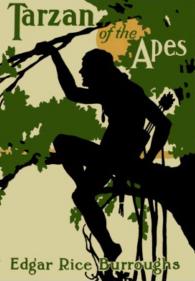Over the past ten or twenty years – and earlier, many novels that had been considered unarguable classics have suffered the indignity of revisionism. Perhaps the clearest example of this is Joseph Conrad’s Heart of Darkness, which is an obvious target for this behavior, because it is one of (if not THE) greatest pieces of prose ever written, but treads in places and attitudes that not even the bravest twenty-first century writer would approach, for fear of being crucified by special interest groups.
It is a work that, despite the efforts of well-meaning but intellectually misguided revisionists can only be truly analyzed and understood within the context of a) its time and b) human nature itself.
Another book that, despite not being quite in the same literary league, generates a similar response, is Tarzan of the Apes – one of Edgar Rice Burroughs three supremely successful fantasy milieus (the others being Barsoom and the Earth’s Core). Though enormously influential in popular culture, the novel itself is seeing a backlash due to its supposedly problematical treatment of non-whites and women.
Now, it’s clear that a book written in 1912 will contain many attitudes that will leave modern readers scratching their heads, but that is part of what makes reading classics a worthwhile.
It’s hard for people to imagine just how much of modern society was created out of whole cloth and necessity in the years of WWI. Everything from women’s expanded role in industry to the breakdown of class barriers got a huge boost by the harsh realities of a Europe that lost an enormous percentage of its young men to the conflict. Reading books from the era immediately before it helps understand both what was gained and what was lost.
Tarzan falls into most of the traps the revisionists dislike, but, at the same time, it is truly an unflinching – if somewhat fantastic – view of what the wilderness would have been like, and is therefore valuable to modern readers. To the revisionists, this is of no moment: they feel that anything which expresses certain attitudes needs to be suppressed – or at least not encouraged. The prevailing attitude seems to be: watch the Disney version if you must, but avoid the novel.
And yet…
And yet, the novel, despite being a little bloodier and a little less pink-lensed than what a modern equivalent would be, is still FUN. The archaic attitudes don’t really distract in the least from the adventure story unless you really, really make an effort to be offended. The good guys and the bad guys are clearly defined, and one can immediately tell what is right and what is wrong.
So this is one that we at Classically Educated recommend with no qualms whatsoever. Our readers – cosmopolitan, open-minded and educated – will be able to accept the anachronisms and enjoy what, 100 years later, is still a cracking good book. If you haven’t already, get your hands on a copy!
As for the revisionists, perhaps we can just all agree to take the classics in the spirit in which they were written and be offended at something else*? Please?
*We propose being offended at the discriminatory practice of painting all bulldozers yellow. Surely that is sinister and hides a racist message of some sort that most people haven’t yet been able decipher. Also, it is an important thing that people care deeply about – we’re not just trying to get you to go away. Honest.


Posted this comment on Facebook, but I’ll post it here as well:
It is absurd to judge works of the early 20th century by 21st century values, but such absurdity runs rampant in certain corners of the writing world. It’s as if some of the writers of today are trying a little too hard to prove they are morally superior to the writers of yesteryear.
LikeLike
Utterly agreed. They are, sadly, all a bit silly in their self-righteous indignation. Or more than just a bit…
LikeLike